Florentin Wörgötter
Leveraging Foundation Models for Multimodal Graph-Based Action Recognition
May 21, 2025Abstract:Foundation models have ushered in a new era for multimodal video understanding by enabling the extraction of rich spatiotemporal and semantic representations. In this work, we introduce a novel graph-based framework that integrates a vision-language foundation, leveraging VideoMAE for dynamic visual encoding and BERT for contextual textual embedding, to address the challenge of recognizing fine-grained bimanual manipulation actions. Departing from conventional static graph architectures, our approach constructs an adaptive multimodal graph where nodes represent frames, objects, and textual annotations, and edges encode spatial, temporal, and semantic relationships. These graph structures evolve dynamically based on learned interactions, allowing for flexible and context-aware reasoning. A task-specific attention mechanism within a Graph Attention Network further enhances this reasoning by modulating edge importance based on action semantics. Through extensive evaluations on diverse benchmark datasets, we demonstrate that our method consistently outperforms state-of-the-art baselines, underscoring the strength of combining foundation models with dynamic graph-based reasoning for robust and generalizable action recognition.
Comparison of marker-less 2D image-based methods for infant pose estimation
Oct 07, 2024Abstract:There are increasing efforts to automate clinical methods for early diagnosis of developmental disorders, among them the General Movement Assessment (GMA), a video-based tool to classify infant motor functioning. Optimal pose estimation is a crucial part of the automated GMA. In this study we compare the performance of available generic- and infant-pose estimators, and the choice of viewing angle for optimal recordings, i.e., conventional diagonal view used in GMA vs. top-down view. For this study, we used 4500 annotated video-frames from 75 recordings of infant spontaneous motor functions from 4 to 26 weeks. To determine which available pose estimation method and camera angle yield the best pose estimation accuracy on infants in a GMA related setting, the distance to human annotations as well as the percentage of correct key-points (PCK) were computed and compared. The results show that the best performing generic model trained on adults, ViTPose, also performs best on infants. We see no improvement from using specialized infant-pose estimators over the generic pose estimators on our own infant dataset. However, when retraining a generic model on our data, there is a significant improvement in pose estimation accuracy. The pose estimation accuracy obtained from the top-down view is significantly better than that obtained from the diagonal view, especially for the detection of the hip key-points. The results also indicate only limited generalization capabilities of infant-pose estimators to other infant datasets, which hints that one should be careful when choosing infant pose estimators and using them on infant datasets which they were not trained on. While the standard GMA method uses a diagonal view for assessment, pose estimation accuracy significantly improves using a top-down view. This suggests that a top-down view should be included in recording setups for automated GMA research.
Deep learning empowered sensor fusion to improve infant movement classification
Jun 14, 2024Abstract:There is a recent boom in the development of AI solutions to facilitate and enhance diagnostic procedures for established clinical tools. To assess the integrity of the developing nervous system, the Prechtl general movement assessment (GMA) is recognized for its clinical value in diagnosing neurological impairments in early infancy. GMA has been increasingly augmented through machine learning approaches intending to scale-up its application, circumvent costs in the training of human assessors and further standardize classification of spontaneous motor patterns. Available deep learning tools, all of which are based on single sensor modalities, are however still considerably inferior to that of well-trained human assessors. These approaches are hardly comparable as all models are designed, trained and evaluated on proprietary/silo-data sets. With this study we propose a sensor fusion approach for assessing fidgety movements (FMs) comparing three different sensor modalities (pressure, inertial, and visual sensors). Various combinations and two sensor fusion approaches (late and early fusion) for infant movement classification were tested to evaluate whether a multi-sensor system outperforms single modality assessments. The performance of the three-sensor fusion (classification accuracy of 94.5\%) was significantly higher than that of any single modality evaluated, suggesting the sensor fusion approach is a promising avenue for automated classification of infant motor patterns. The development of a robust sensor fusion system may significantly enhance AI-based early recognition of neurofunctions, ultimately facilitating automated early detection of neurodevelopmental conditions.
Computer Vision for Primate Behavior Analysis in the Wild
Jan 29, 2024Abstract:Advances in computer vision as well as increasingly widespread video-based behavioral monitoring have great potential for transforming how we study animal cognition and behavior. However, there is still a fairly large gap between the exciting prospects and what can actually be achieved in practice today, especially in videos from the wild. With this perspective paper, we want to contribute towards closing this gap, by guiding behavioral scientists in what can be expected from current methods and steering computer vision researchers towards problems that are relevant to advance research in animal behavior. We start with a survey of the state-of-the-art methods for computer vision problems that are directly relevant to the video-based study of animal behavior, including object detection, multi-individual tracking, (inter)action recognition and individual identification. We then review methods for effort-efficient learning, which is one of the biggest challenges from a practical perspective. Finally, we close with an outlook into the future of the emerging field of computer vision for animal behavior, where we argue that the field should move fast beyond the common frame-by-frame processing and treat video as a first-class citizen.
Multi Sentence Description of Complex Manipulation Action Videos
Nov 13, 2023



Abstract:Automatic video description requires the generation of natural language statements about the actions, events, and objects in the video. An important human trait, when we describe a video, is that we are able to do this with variable levels of detail. Different from this, existing approaches for automatic video descriptions are mostly focused on single sentence generation at a fixed level of detail. Instead, here we address video description of manipulation actions where different levels of detail are required for being able to convey information about the hierarchical structure of these actions relevant also for modern approaches of robot learning. We propose one hybrid statistical and one end-to-end framework to address this problem. The hybrid method needs much less data for training, because it models statistically uncertainties within the video clips, while in the end-to-end method, which is more data-heavy, we are directly connecting the visual encoder to the language decoder without any intermediate (statistical) processing step. Both frameworks use LSTM stacks to allow for different levels of description granularity and videos can be described by simple single-sentences or complex multiple-sentence descriptions. In addition, quantitative results demonstrate that these methods produce more realistic descriptions than other competing approaches.
A Hierarchical Graph-based Approach for Recognition and Description Generation of Bimanual Actions in Videos
Oct 01, 2023



Abstract:Nuanced understanding and the generation of detailed descriptive content for (bimanual) manipulation actions in videos is important for disciplines such as robotics, human-computer interaction, and video content analysis. This study describes a novel method, integrating graph based modeling with layered hierarchical attention mechanisms, resulting in higher precision and better comprehensiveness of video descriptions. To achieve this, we encode, first, the spatio-temporal inter dependencies between objects and actions with scene graphs and we combine this, in a second step, with a novel 3-level architecture creating a hierarchical attention mechanism using Graph Attention Networks (GATs). The 3-level GAT architecture allows recognizing local, but also global contextual elements. This way several descriptions with different semantic complexity can be generated in parallel for the same video clip, enhancing the discriminative accuracy of action recognition and action description. The performance of our approach is empirically tested using several 2D and 3D datasets. By comparing our method to the state of the art we consistently obtain better performance concerning accuracy, precision, and contextual relevance when evaluating action recognition as well as description generation. In a large set of ablation experiments we also assess the role of the different components of our model. With our multi-level approach the system obtains different semantic description depths, often observed in descriptions made by different people, too. Furthermore, better insight into bimanual hand-object interactions as achieved by our model may portend advancements in the field of robotics, enabling the emulation of intricate human actions with heightened precision.
Comparison of Motion Encoding Frameworks on Human Manipulation Actions
Nov 23, 2022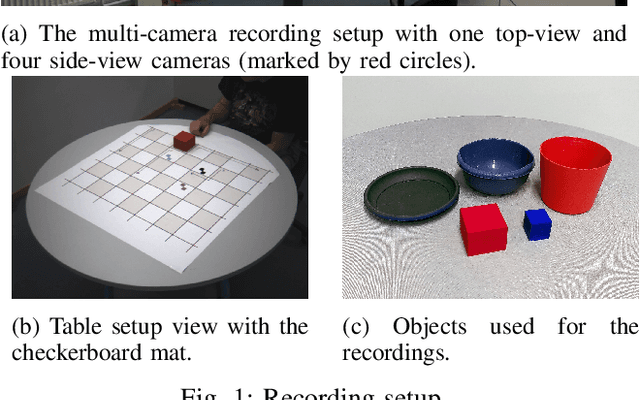
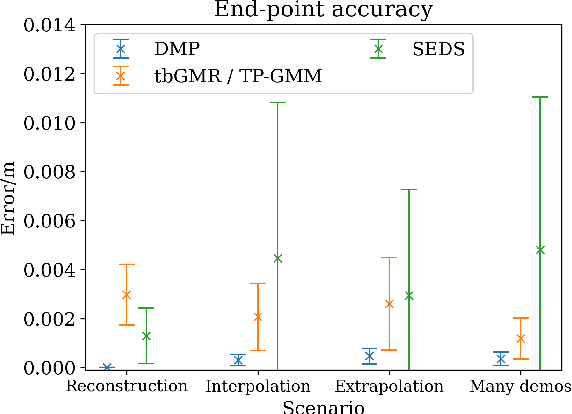
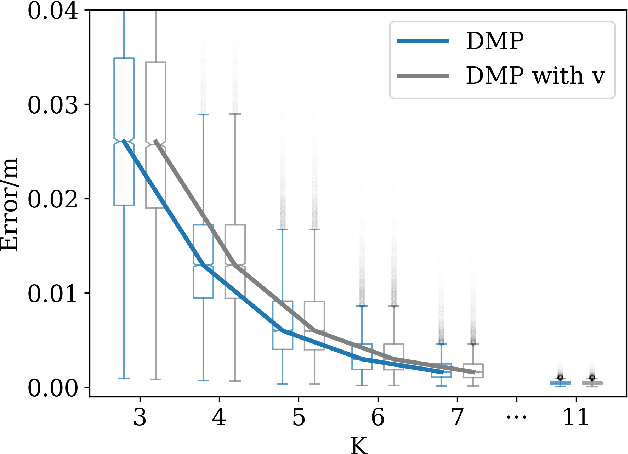
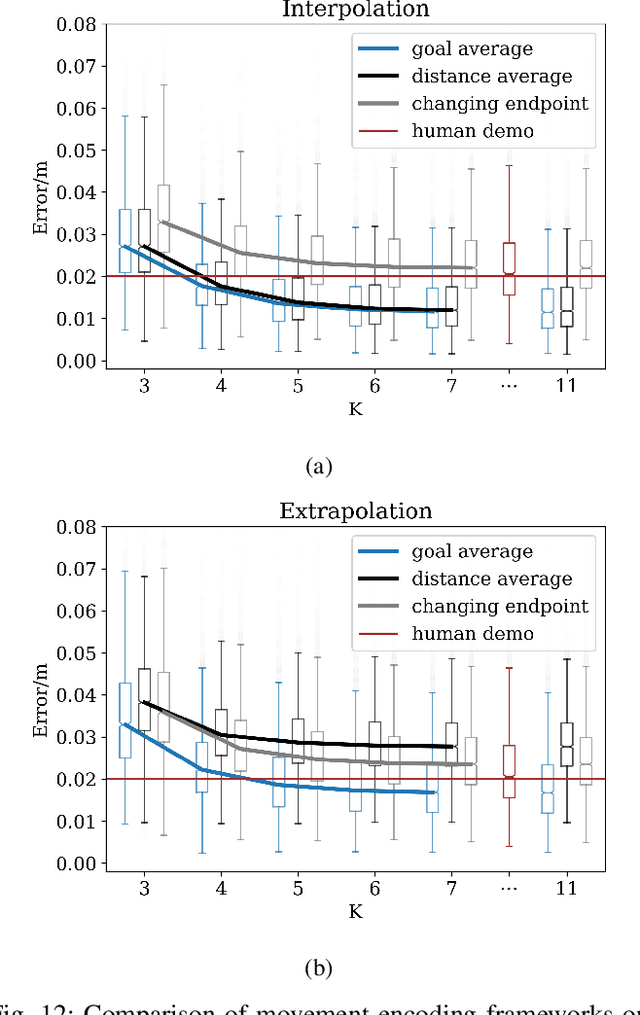
Abstract:Movement generation, and especially generalisation to unseen situations, plays an important role in robotics. Different types of movement generation methods exist such as spline based methods, dynamical system based methods, and methods based on Gaussian mixture models (GMMs). Using a large, new dataset on human manipulations, in this paper we provide a highly detailed comparison of three most widely used movement encoding and generation frameworks: dynamic movement primitives (DMPs), time based Gaussian mixture regression (tbGMR) and stable estimator of dynamical systems (SEDS). We compare these frameworks with respect to their movement encoding efficiency, reconstruction accuracy, and movement generalisation capabilities. The new dataset consists of nine object manipulation actions performed by 12 humans: pick and place, put on top/take down, put inside/take out, hide/uncover, and push/pull with a total of 7,652 movement examples. Our analysis shows that for movement encoding and reconstruction DMPs are the most efficient framework with respect to the number of parameters and reconstruction accuracy if a sufficient number of kernels is used. In case of movement generalisation to new start- and end-point situations, DMPs and task parameterized GMM (TP-GMM, movement generalisation framework based on tbGMR) lead to similar performance and outperform SEDS. Furthermore we observe that TP-GMM and SEDS suffer from inaccurate convergence to the end-point as compared to DMPs. These different quantitative results will help designing trajectory representations in an improved task-dependent way in future robotic applications.
Simulated Mental Imagery for Robotic Task Planning
Nov 23, 2022



Abstract:Traditional AI-planning methods for task planning in robotics require symbolically encoded domain description. While powerful in well-defined scenarios, setting this up requires substantial effort. Different from this, most everyday planning tasks are solved by humans intuitively, using mental imagery of the different planning steps. Here we suggest that the same approach can be used for robots, too, in cases which require only limited execution accuracy. In the current study, we propose a novel sub-symbolic method called Simulated Mental Imagery for Planning (SiMIP), which consists of several steps: perception, simulated action, success-checking and re-planning performed on 'imagined' images. We show that it is possible this way to implement mental imagery-based planning in an algorithmically sound way by combining regular convolutional neural networks and generative adversarial networks. With this method, the robot acquires the capability to use the initially existing scene to generate action plans without symbolic domain descriptions, hence, without the need to define an explicit representation of the environment. We create a dataset from real scenes for a packing problem of having to correctly place different objects into different target slots. This way efficiency and success rate of this algorithm could be quantified.
Infant movement classification through pressure distribution analysis -- added value for research and clinical implementation
Jul 26, 2022
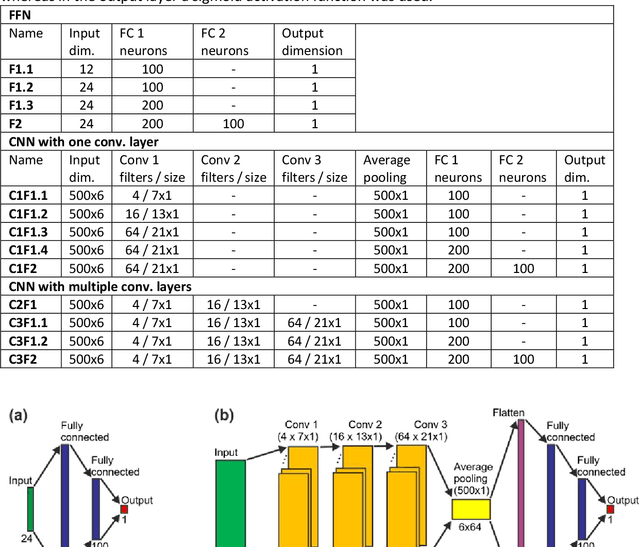


Abstract:In recent years, numerous automated approaches complementing the human Prechtl's general movements assessment (GMA) were developed. Most approaches utilised RGB or RGB-D cameras to obtain motion data, while a few employed accelerometers or inertial measurement units. In this paper, within a prospective longitudinal infant cohort study applying a multimodal approach for movement tracking and analyses, we examined for the first time the performance of pressure sensors for classifying an infant general movements pattern, the fidgety movements. We developed an algorithm to encode movements with pressure data from a 32x32 grid mat with 1024 sensors. Multiple neural network architectures were investigated to distinguish presence vs. absence of the fidgety movements, including the feed-forward networks (FFNs) with manually defined statistical features and the convolutional neural networks (CNNs) with learned features. The CNN with multiple convolutional layers and learned features outperformed the FFN with manually defined statistical features, with classification accuracy of $81.4\%$ and $75.6\%$, respectively. We compared the pros and cons of the pressure sensing approach to the video-based and inertial motion senor-based approaches for analysing infant movements. The non-intrusive, extremely easy-to-use pressure sensing approach has great potential for efficient large-scaled movement data acquisition across cites and for application in busy daily clinical routines for evaluating infant neuromotor functions. The pressure sensors can be combined with other sensor modalities to enhance infant movement analyses in research and practice, as proposed in our multimodal sensor fusion model.
Open video data sharing in developmental and behavioural science
Jul 22, 2022



Abstract:Video recording is a widely used method for documenting infant and child behaviours in research and clinical practice. Video data has rarely been shared due to ethical concerns of confidentiality, although the need of shared large-scaled datasets remains increasing. This demand is even more imperative when data-driven computer-based approaches are involved, such as screening tools to complement clinical assessments. To share data while abiding by privacy protection rules, a critical question arises whether efforts at data de-identification reduce data utility? We addressed this question by showcasing the Prechtl's general movements assessment (GMA), an established and globally practised video-based diagnostic tool in early infancy for detecting neurological deficits, such as cerebral palsy. To date, no shared expert-annotated large data repositories for infant movement analyses exist. Such datasets would massively benefit training and recalibration of human assessors and the development of computer-based approaches. In the current study, sequences from a prospective longitudinal infant cohort with a total of 19451 available general movements video snippets were randomly selected for human clinical reasoning and computer-based analysis. We demonstrated for the first time that pseudonymisation by face-blurring video recordings is a viable approach. The video redaction did not affect classification accuracy for either human assessors or computer vision methods, suggesting an adequate and easy-to-apply solution for sharing movement video data. We call for further explorations into efficient and privacy rule-conforming approaches for deidentifying video data in scientific and clinical fields beyond movement assessments. These approaches shall enable sharing and merging stand-alone video datasets into large data pools to advance science and public health.
 Add to Chrome
Add to Chrome Add to Firefox
Add to Firefox Add to Edge
Add to Edge